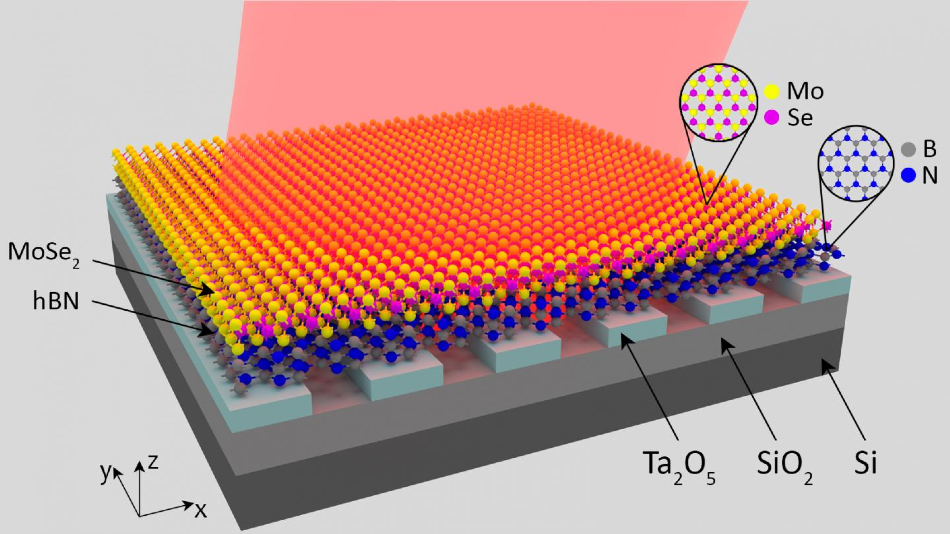Apr 10 2020
Top research teams in technologies related to nanophotonics are actively looking for ways to create optical transistors, which are believed to be crucial components for upcoming optical computers.
 Photons do not interact with each other well, which creates a big problem for microelectronics engineers. A group of researchers from ITMO University, together with colleagues, have come up with a new solution to this problem by creating a planar system where photons couple to other particles, which enables them to interact with each other. Image Credit: Department of Physics, ITMO University.
Photons do not interact with each other well, which creates a big problem for microelectronics engineers. A group of researchers from ITMO University, together with colleagues, have come up with a new solution to this problem by creating a planar system where photons couple to other particles, which enables them to interact with each other. Image Credit: Department of Physics, ITMO University.
Such devices have the ability to process data with photons rather than electrons and, thus, decrease the heat and boost the operational speed. But photons do not interact effectively with one another, which poses a major challenge to microelectronics designers.
Now, a research team from ITMO University, along with its collaborators, has developed a novel solution to this issue by producing a planar system in which photons bind to other particles that allow the photons to communicate with one another.
The principle shown in the researchers’ experiment can offer a platform for creating next-generation optical transistors. The study results were published in the Light: Science & Applications journal.
Transistors are crucial elements of the contemporary digital world. It is well known that the regulated movement of electrons is responsible for the function of transistors. While this method has been utilized for many years, it has a number of disadvantages.
First and foremost, when electronic devices carry out a task, they have a tendency to heat up. This implies that some of the energy is wasted in the form of heat and not utilized for the intended task.
To overcome this heating problem, the devices should be equipped with coolers but this can lead to more energy consumption. Second, electronic devices are known to have a reduced processing speed.
A few of these problems can be overcome by employing photons, or light particles, rather than electrons. Devices that utilize photons for data encoding purposes would demand less energy, generate less heat, and thus work more quickly.
That is the reason why researchers around the world are undertaking studies in the area of optical computers. But the major issue is that unlike electrons, photons do not interact effectively with one another. Globally, scientists have proposed a variety of techniques to “train” photons to communicate with one another.
The idea provided by one of these techniques is to bind photons with other kinds of particles. A research team from the Department of Physics and Engineering at ITMO University, along with collaborators, has shown a novel efficient implementation, in which photons bind to excitons in single-layer semiconductors.
When electrons are stimulated, they leave behind vacant valence bonds (or electron holes, as referred by physicists). This phenomenon results in the formation of excitons in semiconductors. The electron, as well as its hole, are capable of interacting with one another, producing a novel particle—an exciton, which consequently communicates with other excitons.
If we strongly couple excitons to light particles, we will get polaritons. These are partly light, meaning that they can be used to transfer information very fast; but at the same time they can interact with each other very well."
Vasily Kravtsov, Study Co-Author and Leading Research Fellow, ITMO University
It appears that polaritons offer a simplified solution, and all that is required to do is to produce a polariton-based transistor. But this is easier said than done—a system has to be developed where these particles could exist sufficiently for a long time yet still maintain their excellent interaction strength.
In the laboratories of ITMO University’s Department of Physics and Engineering, polaritons are produced with the aid of a waveguide, a laser, and a very thin layer of molybdenum diselenide semiconductor.
A semiconductor layer, which has a thickness of only three atoms, is positioned on a nanophotonic waveguide, with an accurate net of extremely fine grooves etched on its surface. Subsequently, it is illuminated with a red laser to produce excitons in the semiconductor layer. These excitons create polaritons by binding with light particles, and these polaritons are subsequently “trapped” in the system.
Polaritons acquired in this manner not only exist for comparatively longer durations but also have additional high nonlinearity, implying that they actively communicate with one another.
It brings us closer to creating an optical transistor, as we now have a planar platform less than 100 nanometers thick, which could be integrated on a chip. As the nonlinearity is rather high, we would not need a powerful laser—a small red light source will suffice, which could also be integrated onto the chip."
Vasily Kravtsov, Study Co-Author and Leading Research Fellow, ITMO University
The research is ongoing at the moment, as scientists need to prove the efficiency of their novel system at room temperatures.